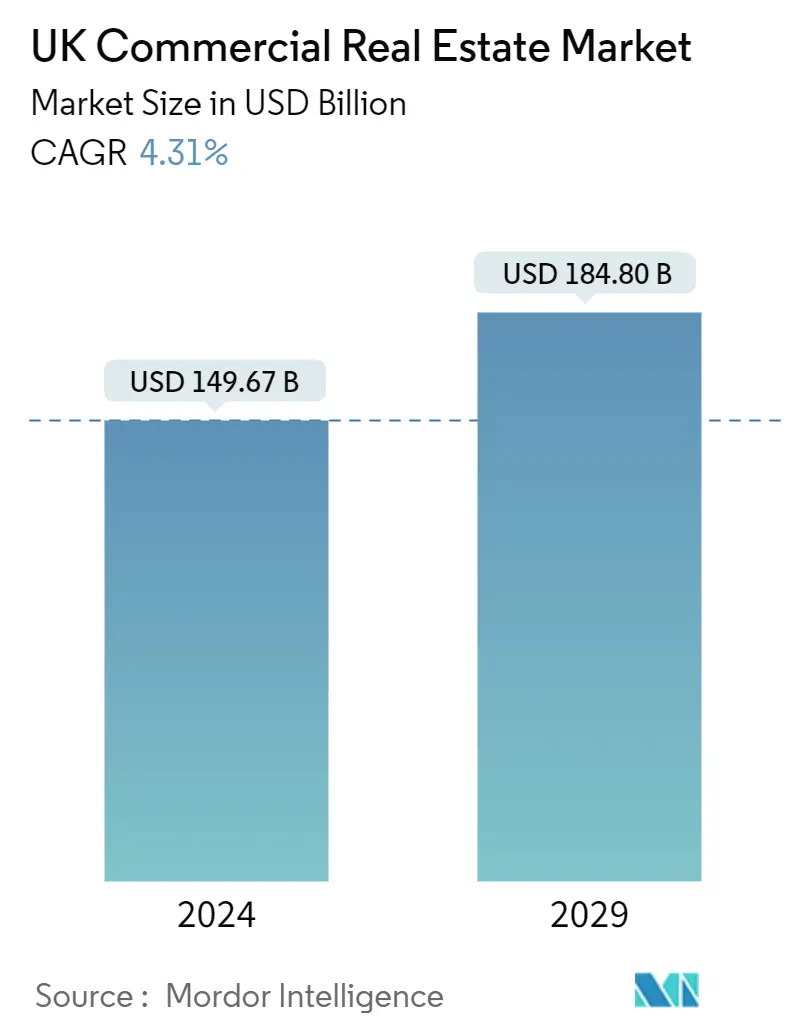Market Size of UK Commercial Real Estate Industry

| Study Period | 2020 - 2029 |
| Base Year For Estimation | 2023 |
| Market Size (2024) | USD 149.67 Billion |
| Market Size (2029) | USD 184.80 Billion |
| CAGR (2024 - 2029) | 4.31 % |
| Market Concentration | Low |
Major Players
*Disclaimer: Major Players sorted in no particular order |
UK Commercial Real Estate Market Analysis
The UK Commercial Real Estate Market size is estimated at USD 149.67 billion in 2024, and is expected to reach USD 184.80 billion by 2029, growing at a CAGR of 4.31% during the forecast period (2024-2029).
- High inflation is putting more pressure on companies to cut costs, prompting them to focus on increasing productivity and reducing costs. More than seven in ten (75%) respondents to the Quarterly Industry Survey (Q3 2023) of the Research, Information and Consulting Society (RICS) predicted that corporate cash flows would continue to deteriorate over the next 12 months. This, combined with the long-term effects of the “work from home” revolution, means many companies are still evaluating their real estate footprint – though the extent of downsizing is very business-specific.
- According to Remit Consulting, office occupancy levels stabilized at around 30% over the past year, and a three-day workweek appears to be the new norm. However, there needs to be more evidence for any long-term changes in office attendance. Employee demand for hybrid working continues to grow. For instance, according to a recent Remit Consulting survey, 69% of staff say they enjoy working from home, but almost 60% say they would consider quitting if they were required to work from home. Similarly, a Deloitte study found that more than 75% of the Gen-Z generation would consider looking elsewhere if asked to go back to the office five days a week.
- While corporate real estate is second only to salaries for many companies, the need for high-quality space continues to drive recruitment, retention, productivity, and staff health and well-being. This is why there continues to be a strong need for high-quality space.
- Due to a combination of evolving occupier needs and legislation, the overall amount of office space required will be lower in the future, with a greater emphasis on high-quality buildings meeting these corporate and regulatory needs. Life sciences and technology have played a key role in sustaining market growth. New technologies such as AI will further enhance the importance of offices as a high-quality environment.
UK Commercial Real Estate Industry Segmentation
Commercial real estate is a property used exclusively for business-related purposes or to provide a workspace rather than as a living space. Most often, commercial real estate is leased to tenants for income-generating activities. In general, it includes buildings used for commercial purposes, including office buildings, warehouses, and retail buildings (e.g., convenience stores, 'big box stores, and shopping malls).
The UK commercial real estate market is segmented by type (office, retail, industrial and logistics, hospitality, and other types [schools and recreational areas]) and key city and region (England, Wales, Northern Ireland, Scotland, London [City], and the Rest of United Kingdom). The report offers market size and forecast values for the UK commercial real estate market in value (USD) for all the above segments.
| By Type | |
| Offices | |
| Retail | |
| Industrial and Logistics | |
| Hospitality | |
| Other Types (Schools, Recreational Areas) |
| By Key City and Region | |
| England | |
| Wales | |
| Northern Ireland | |
| Scotland | |
| London (City) | |
| Rest of United Kingdom |
UK Commercial Real Estate Market Size Summary
The UK commercial real estate market is poised for steady growth over the forecast period, driven by evolving corporate needs and a strong demand for high-quality office spaces. Despite the challenges posed by high inflation and the lingering effects of the work-from-home trend, the market is adapting to new realities, with a significant focus on hybrid working models. The demand for premium office spaces is expected to outpace supply, leading to increased competition and higher rental rates, particularly in prime locations. Sectors such as life sciences and technology are contributing to market resilience, with advancements in technology like AI further enhancing the appeal of high-quality office environments. The retail sector, while facing challenges, is seeing a shift towards retail parks and diversified investment strategies, as online penetration stabilizes and physical stores seek to boost profitability.
The commercial real estate landscape in the UK remains highly competitive, attracting both domestic and international investors. Key players such as Land Securities Group PLC, Segro PLC, British Land, Derwent London, and Hammerson are actively involved in significant urban regeneration projects, aiming to stimulate growth and create new opportunities. The market's attractiveness is further bolstered by the growing property tech sector, which simplifies investment processes. Recent developments, such as British Land's last-mile logistics scheme in Southwark, highlight the ongoing commitment to enhancing urban infrastructure. As the market continues to evolve, the emphasis on high-quality, strategically located properties is expected to drive future growth and investment.
UK Commercial Real Estate Market Size - Table of Contents
-
1. MARKET INSIGHTS
-
1.1 Current Economic Scenario and Consumer Sentiment
-
1.2 Commercial Real Estate Buying Trends - Socioeconomic and Demographic Insights
-
1.3 Government Initiatives and Regulatory Aspects for Commercial Real Estate Sector
-
1.4 Insights into Existing and Upcoming Projects
-
1.5 Insight into Interest Rate Regime for General Economy and Real Estate Lending
-
1.6 Insights into Rental Yields in Commercial Real Estate Segment
-
1.7 Insights into Capital Market Penetration and REIT Presence in Commercial Real Estate
-
1.8 Insights into Public-Private Partnerships in Commercial Real Estate
-
1.9 Insights into Real Estate Tech and Startups Active in Real Estate Segment (Brokerage, Social Media, Facility Management, and Property Management)
-
1.10 Impact of COVID-19 on the Market
-
-
2. MARKET SEGMENTATION
-
2.1 By Type
-
2.1.1 Offices
-
2.1.2 Retail
-
2.1.3 Industrial and Logistics
-
2.1.4 Hospitality
-
2.1.5 Other Types (Schools, Recreational Areas)
-
-
2.2 By Key City and Region
-
2.2.1 England
-
2.2.2 Wales
-
2.2.3 Northern Ireland
-
2.2.4 Scotland
-
2.2.5 London (City)
-
2.2.6 Rest of United Kingdom
-
-
UK Commercial Real Estate Market Size FAQs
How big is the UK Commercial Real Estate Market?
The UK Commercial Real Estate Market size is expected to reach USD 149.67 billion in 2024 and grow at a CAGR of 4.31% to reach USD 184.80 billion by 2029.
What is the current UK Commercial Real Estate Market size?
In 2024, the UK Commercial Real Estate Market size is expected to reach USD 149.67 billion.

